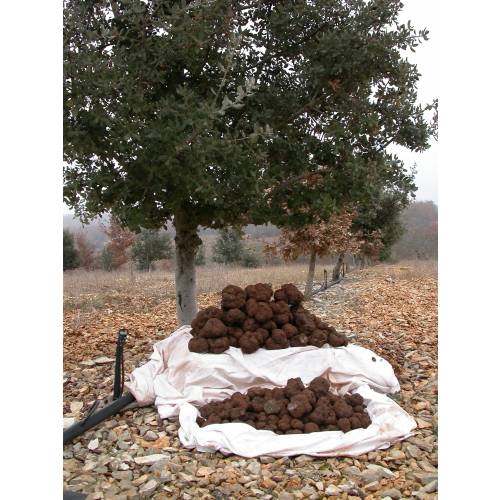
The truffle and it growing
The history of Black Truffle growing
- Details
-
The Black Truffle (Tuber melanosporum) has been considered since the 19th century as « the black diamond» of French cooking. Just like precious stones, its rarity and exceptional culinary qualities have intrigued the great chefs and bewitched those who have had the chance to taste it.
It is a fungus that lives in symbiosis on the roots of certain varieties of tree such as the oak and hazel. The tree provides the fungus with the required sugars to live and in exchange, the truffle helps the tree’s roots to better absorb the essential minerals. The truffle can only grow in chalky soils and needs direct sunlight on the ground to produce the fruit that we are so keen to eat. It does not grow in dense forests but on the edge of woods in clearings or under a lone tree.
The rapid development of truffle culture is largely due to the epidemic of phylloxera that affected the vineyards at the end of the 19th century. Effectively the French vines were devastated by this insect originating from North America, leaving thousands of hectares as fallow land where little by little the truffle oaks established themselves!
Man then began to try and understand how the truffles grew and the first plantations began to appear. The approach was then largely empirical; an acorn from a productive oak was planted along with a small piece of truffle. The results were uncertain but given the vast surfaces planted up to a 1000 tonnes of truffles per annum were being harvested by the beginning of the 20th century.
The two world wars along with the exodus from the countryside and intensive farming had a big impact on truffle growing and by the 1970’s the production had fallen to about 30 tonnes per annum.
It was because of this that Institut National de Recherche Agronomique (I.N.R.A. - National Institute for Agricultural Research) began to tackle the truffle problem and along with the company Agri Truffe succeeded in producing the first certified mycorrhizae trees. Thus began the new era for truffle growing which now boasts reliable and productive plants. These truffle trees are now planted successfully throughout the world in countries like New Zealand, Morocco, the USA and even in Sweden using the Bourgogne Truffle.
Overproduction may appear a problem but truffle growing does not respond well to intensive farming. In reality the greater the soil’s biodiversity the greater the chance of successful truffle growing. The truffle grower does not try to force nature’s hand but attempts to establish the right balance in the complex ecosystem that involves the soil, the tree and the fungus.
The production levels in Frances are very variable from year to year. In 2009/2010 about 40 tonnes of truffles were produced which is ten times less than the demand, because of this prices remain very high at between 800 and 1500€ the kilo and there is a desperate need to plant more! - Photos (1)

